
10 minute read
Megasailer: 112' Baltic Yachts Liara
Pure, simple lines wrap this elegant yet practical yacht designed for cruising but also well able to acquit herself in racing. For Baltic and Malcolm McKeon, she posed an intriguing engineering challenge which Adam Lay’s interior design clothes to perfection
by Paola Bertelli - ph. by Josh Czachur, Breedmedia
Advertisement

fter she cast off from the Monaco Yacht Show, Liara set a course for the Caribbean on the first long leg of a voyage that will take her to New Zealand in time to watch the 2021 America’s Cup. That schedule very much reflects the 112 footer’s own DNA – she is a long-distance cruising yacht at heart but also ready and able to fend off the competition between the marks. Liara was splashed by Baltic Yachts in May 2019 during a record 10-day period that saw no less than three big launches: the first was the 67’ Lurgina followed by the 112’ Liara and lastly, the 142’ Canova. A triumphant end to three years of incredibly hard work for the Jakobstad yard in Finland. Liara is a strikingly graceful boat, an effect very deliberately achieved through a spare, pared-back exterior design: clean lines and strong geometries offset by the soft forms of the superstructure which has been kept as low and streamlined as possible. Liara’s exteriors and hull are the work of the Malcolm McKeon Yacht Design studio. One of the key features of her styling is the wide, curved glass companionway doors separating the cockpit and saloon. These not only create an interior-exterior dialogue, something rarely seen on a sailing yacht, but are also a strong design element in their own right. Protected by an original hard top, the cockpit leads into the dramatic full width deck saloon, providing the first glimpse of the superb Adam Lay Studio-styled accommodation. The saloon is a fine example of a space flooded with natural light thanks to the enormous amount of glazing incorporated as part of Malcolm McKeon’s exterior styling. “The design brief for Liara,” explains Adam Lay, “was to create a practical, functional sailing yacht interior with an open feel that reflects the natural environment of the owner’s home islands, the Channel Islands, which are located between England and France. Liara’s interior is intentionally ‘weathered’ to look and feel natural, comfortable and relaxing – like the Channel Islands themselves”. Light colours and lots of oak provide the leitmotif aboard. The oak appears in many guises and finishes designed, as Lay stresses, to give create a relaxed atmosphere that feels like nature is part of the interior. Good examples are the dining and coffee table tops which mimic ripples in calm water and also the hanging locker doors inspired by the look of water or tree bark. The textures of some of the fabrics used continue this aesthetic, while carefully positioned lighting picks out and highlights the elements. The work of painter Valerie Travers, from Guernsey in the Channel Islands, adds an artistic flourish too. The choice of a telescopic keel was pivotal to the interior arrangement as unlike a lifting keel, it does not encroach into the accommodation. This meant that every last square metre available could be used for the split-level saloon in which the dining and lounge area is separated from the relaxation and media area by a few steps. The sleeping quarters has a nicely harmonious style too. The master suite is forward with the VIP stateroom just behind it and, amidships, aft of the saloon, two further en-suite twin cabins. The fabrics and headrests on the beds, however, are different colours which adds a personal touch to each space. Lastly, a large lithium ion battery bank ups guest comfort levels aboard as Liara can operate in ‘silent’ mode for up to eight hours with all her hotel services running. www.balticyachts.fi
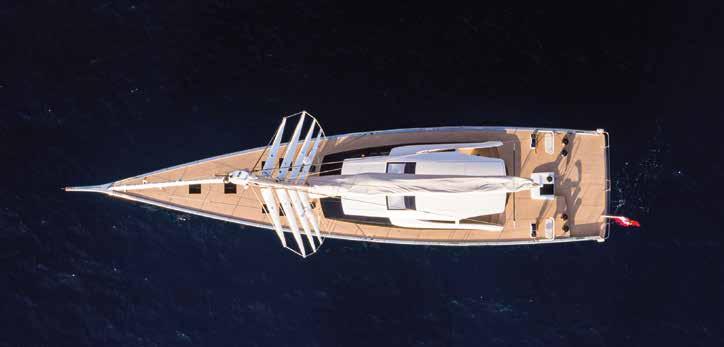
@@@cepe pre doluptio quiae non con es des et id most eos sunt eictotae volo eum veris diasperuptat opta dellanis estia consequid qui ipsus eliquae prestib usandae rferroribus, conecat uribusa cum ut vit erovid maio coreic to officat as as volorias as eatecto blaut et liti assit quatur aliquias est et et, et odic tem rem. Fero dem dolo opta simi, occum ratia dolore nosae ratist prerias sitatus

The cockpit is home to two separate areas: dining and conversation. The wide curved glass companionway doors not only maintain a connection with the deck saloon but provide the helmsman with a sightline right forward. Opposite, an aerial photo highlights just how clean and uncluttered the synthetic teak deck is
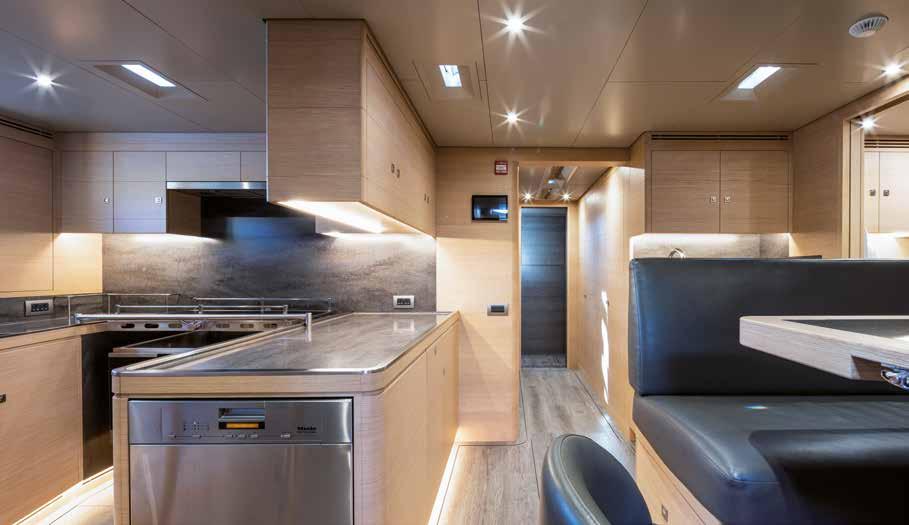

Oak is the main wood used aboard. The interiors are intentionally weathered to look and feel more natural, comfortable and relaxing. Above, the master suite forward. Right, one of the three guest staterooms. Opposite, the bright, airy saloon and below, the galley with crew mess. The crew quarters have their own separate access aft
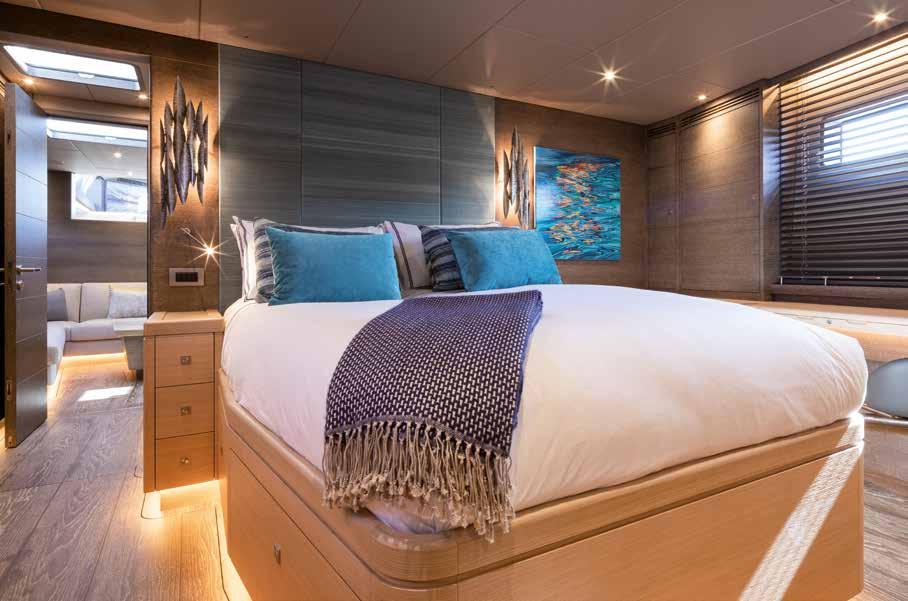
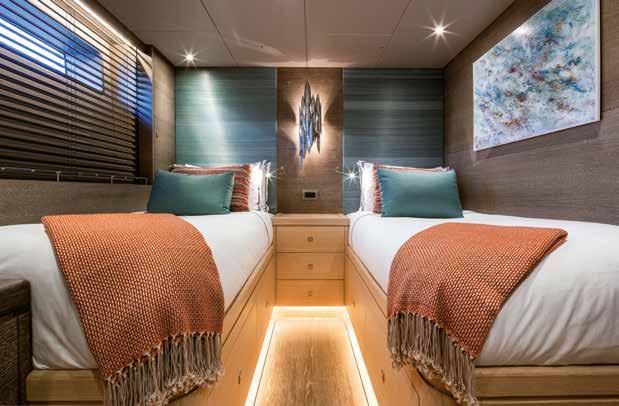
Weight-saving was pivotal to the success of the project: Liara is built from carbon composite with foam and Nomex cores and, as a result, weighs a mere 88 tonnes. Even the furnishings are made from wood-veneered composite. Right, the view from the saloon is truly extraordinary

Exterior Designer and Naval Architecture
Malcolm McKeon - Malcolm McKeon Yacht Design
Ihave known the owner very well for a long time and around 20 years ago, I designed his 50’ Eagle, an IMS racing yacht. When I opened my own studio, he asked me to design his new cruising yacht. He wanted something fast and built from carbonfibre that he could sail all over the world in with his wife and family. But then as we developed the project, he began to change his mind a bit and decided he also wanted to do some racing. Cruising remained the main priority, of course, but… from that point on, we focused on weight. We had to really restrict it as much as possible but without compromising on onboard comfort in anyway, particularly when it came to vibration and noise which can be quite significant on racing craft. To maximise performance, we designed various hull forms and appendages which we then evaluated with CFD (computerised fluid dynamics) simulations. The main challenge with Liara came from the choice of having a telescopic keel and retractable propulsion system. This involved a lot of very complex engineering being done on the hull: the two large holes in the bottom – for the keel and the retractable propeller – meant the hull had to be reinforced with a carbon-fibre frame. The owner wanted a low, streamlined superstructure. The wide, curved glass companionway doors ensure that you won’t be heard when you are in the saloon and are isolated from whatever is happening out on deck. This glass companionway also provides the helmsman with a sightline right forward. Aesthetically, the design of the carbon-fibre hard top bimini, which can be removed for racing, is the result of a subtle balance between the height of the bimini and superstructure in order to ensure the boat looks harmonious both with and without the former. Liara is a fast cruiser that will eat up many, many miles. Her owner has already sailed her from Finland to the Mediterranean. After the Monaco Yacht Show, he cast off for Palma and is now in Antigua. They will also be starting racing soon…..

Interior Designer

Adam Lay, principal of Adam Lay Studio
The owner gave us a very clear design brief and he trusted us to create a beautiful, practical interior for him and his family. We worked closely with him and his wife to agree the interior design using hand-drawn pencil artist’s impressions accompanied by mood boards showing hardware, finishes and soft furnishings. Good communication with the owner, his captain, the project manager and the shipyard was key throughout. Malcolm McKeon Yacht Design gave us an absolute gift in terms of the structure and space planning for the saloon which, in terms of its feeling of openness, is incomparable with any vessel of Liara’s size. I would argue this area of the yacht boasts a game-changing design – albeit a challenge for the shipyard to accommodate the necessary ducting and pipework from the midship section to the aft cockpit area. The result is a very open feel to the saloon and a remarkable connection to the cockpit, making both spaces flow together. Oak is the main finish we chose for Liara. We used a balance of grey stained and limed oak, and a light bleached oak that mimics the colours of local rocks and driftwood. This neutral backdrop is intended to futureproof the vessel in the event of resale, allowing any potential new owner to dress the interior to their own taste. We also designed the coffee tables and dining table in the saloon. The bases and tops were built by Baltic Yachts, but then the tops were sent to the UK to a special finishes company, Parkway Interiors Specialist Finishing, not far from my studio in Hampshire, UK. They worked closely with us to create the rippled water effect you see on the table tops. In terms of artificial lighting design, we used accent lighting to lift the outboard structure in the saloon and we carefully positioned downlights to highlight features like the rippled oak on the hanging locker doors. It is also important to balance ‘effect’ lighting with ‘practical’ lighting for reading in bed and face lighting in the bathrooms, for example. My favourite area aboard? Definitely the saloon. There is so much natural light, a great connection with the cockpit and the ocean, and it feels like you’re onboard a yacht that is much bigger than 112’.

Henry Hawkins, Executive Vice President

For Baltic, Liara is another further leap forward in building hightech innovative lightweight composite performance cruisers. We began building Liara with the main targets of this project firmly in our minds: a world cruising, safe, reliable, comfortable performance sailing yacht. A project that from the pre-engineering to final boat phases took three years to complete. Liara was full of technical challenges. For instance, the bimini was a structural challenge: we had to maintain its integrity but, at the same time, keep the weight to a minimum to allow ease of removal. The bimini was created to provide protection from the elements and to create a feeling of “safety” whilst above deck. The seating area beneath is fully covered by the bimini and there are soft windows to be used on the sides for closing the area off from wind, rain and sun. There is a sliding panel in the roof to provide a sunbathing area during the day or view of the stars at night in the aft portion of the cockpit. The bimini is removable for racing. The high voltage electrical system and the 350 bar hydraulic system were major challenges from a technological point of view, while the bridle system for the jib controlled by 3 cylinders is highly innovative. The yacht was to be used both as a cruiser and for racing so this meant we had to evaluate every detail in the matter of weight: hose clamps for ducting, electrical cable trays made from carbon. We also used Nomex in the aft ship bulkheads for weight-saving and titanium deck equipment, etc. The RPS (retractable propulsion system) will boost performance. I would describe Liara as elegant, safe yet adventurous. My favourite place aboard? Behind the wheel, of course! The opportunities! I would describe Liara as elegant, safe yet adventurous.

Stretching 34 metres in length and 7.9 in the beam, Liara has an imposing 750 sqm sail plan. Her telescopic keel means her draught can be cut from 6.5m to just 3.91. Liara’s stern design (opposite, bottom) is particularly sophisticated as the synthetic teak used on the deck melds into the original curve of the transom
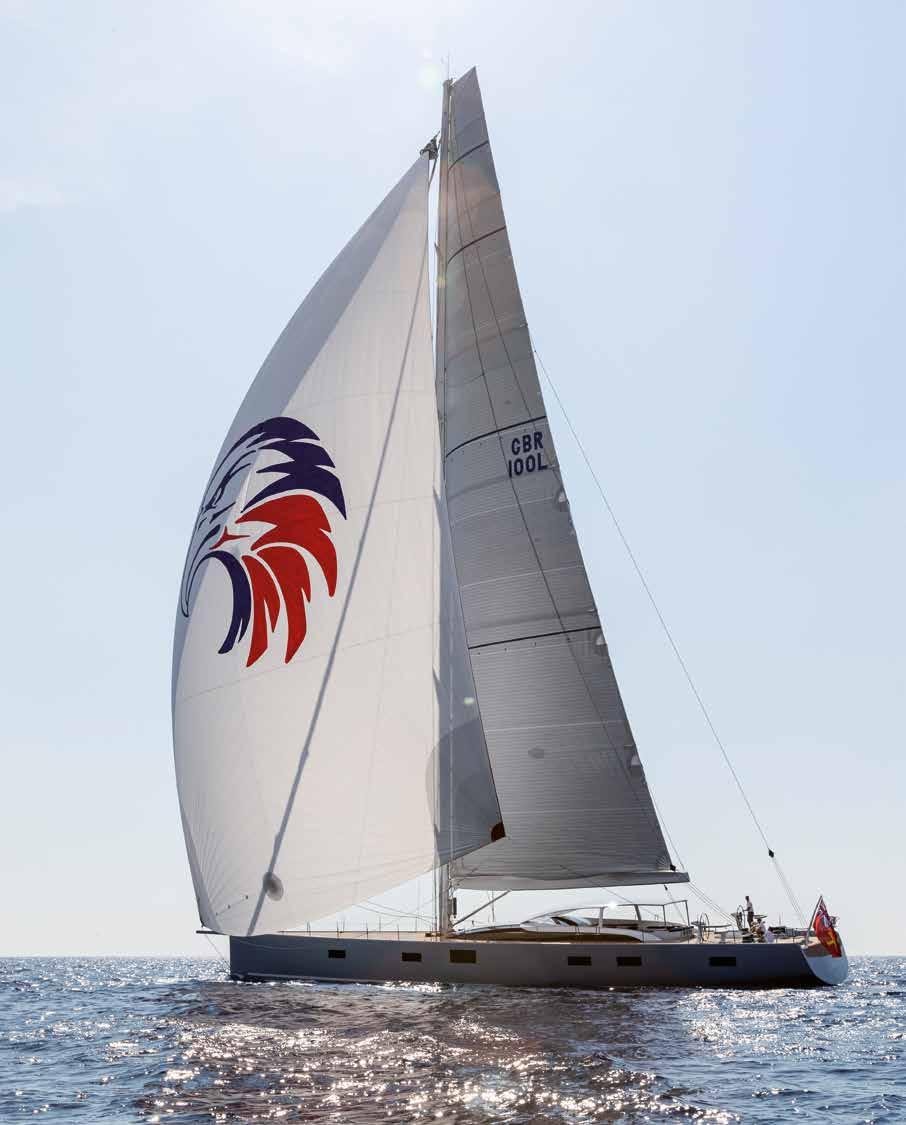
@@@@quid eosaperferro officillorat pa volescil ende etur, cuptatem facia con rererovitas repernam consequisse vellacia pero ime et volupta num repta amus et eos es quam volorum rest idi officitas prorehe ndiaeptaque quam corest, ommolup taquae porrumquod modis rem eum Lam idi doloratur? Tas vellabori tem doluptiantes conse aut voluptae es dolore sitas apiendusam ad enisquatusam quibus eum dolut rem enda










